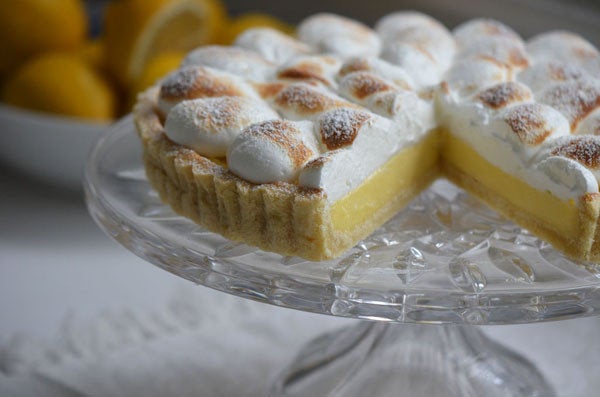
No dessert has the ability to bring happiness like pie can. Pie is both humble and complex, and perfectly comforting. And with all those qualities in mind, we went searching for the best summer pie recipe that we could enjoy all summer long. And just like when we looked for the ultimate chocolate chip cookie or a perfect rhubarb spring recipe, we were wildly successful.
Not only did we come across more mouth-watering pies than we knew existed, but we found one that's particularly special, and it comes in the form of a lemon meringue pie. Congratulations to Maureen Abood, of the blog Rose Water & Orange Blossoms for making us drool (against our will) over this perfect pie -- and for winning the Emile Henry 12" Pie Dish and title of Best Summer Pie. You can get the recipe below.
If the thought of making meringue has you breaking out in sweats, don't let that deter you from trying this pie. Trust us, it's worth the effort. And we're here to help. You can follow these step-by-step instructions, watch a video, or both, and you'll be ready to whip this pie together with unprecedented ease.
For the lemon cream:
1 1/3 cups sugar
Finely grated zest of 3 organic lemons
4 large eggs
3/4 cup freshly squeezed lemon juice (4-5 lemons)
2 sticks plus 5 tablespoons (10 1/2 oz.) unsalted butter, room temperature, cut into 1-inch pieces
For the press-in crust:
1 2/3 cups unbleached, all-purpose flour
1/4 cup sugar
1/4 cup slivered almonds
10 tablespoons (1 1/4 sticks) chilled unsalted butter, cut into 1/2-inch cubes
1 large egg, lightly beaten
For the meringue:
4 egg whites, room temperature
1/8 teaspoon cream of tartar
1 cup sugar
Powdered sugar for garnish
For the lemon cream (can be made in advance):
Bring a few inches of water to a simmer in a saucepan. Place the sugar and zest in a large metal bowl that fits over the pan of simmering water as a double boiler (without the water touching the bottom of the bowl). Off heat, work the sugar and zest together between your fingers until the sugar is moist, grainy and very aromatic. Whisk in the eggs, then the lemon juice.
Place the bowl over the saucepan on medium high heat. Cook, whisking constantly, until the curd reaches 180°F. The mixture will start to thicken and the whisk will leave tracks as it heats up. At 180°F, remove from the heat and strain the curd into the container of a blender (or food processor); discard the zest. Let the cream rest and cool slightly, stirring occasionally, for about 10 minutes.
Turn the blender to high and incorporate five pieces of butter at a time. Turn off the blender and scrape down the sides of the container as needed while you're incorporating the butter. Beat for an additional three minutes after all of the butter is in. Pour into a container, press a piece of plastic wrap against the surface to create an airtight seal, and chill for eight hours or overnight. The curd keeps for four days, chilled. When you are ready to construct the tart, just whisk the cream to loosen it and spoon it into the tart shell.
For the press-in crust (can be made in advance):
Blend the flour, sugar and almonds in a food processor until the nuts are finely ground. Using on/off turns, cut in the butter until a coarse meal forms. Add the egg and blend just until dough forms. Gather dough into ball; flatten into a square 1-inch thick, wrap in plastic, and chill 1 hour.
Line the bottom of a 10-inch round removable bottom tart pan with parchment paper. Cut the dough into 1-inch slices. Lay the slices in the bottom of the pan and push them together, closing all fissures tightly. Press the bottom of a glass against the dough to flatten and smooth. Then line the edges of the tart with slices of dough placed horizontally around the fluted edges. Press this dough into the bottom of the crust and into the fluted rim. Refrigerate the crust for one hour.
Preheat oven to 375°F. Bake the crust until golden brown, about 17 minutes. Remove the crust from the oven. You will notice that the crust is somewhat puffed up; this should be tamped down with the bottom of a glass or similar flat, heavy tool. Cool the crust and then remove the fluted ring by setting the tart pan over a jar and letting the ring fall to the counter. Use a flat metal spatula to lift the tart off of the metal tart pan bottom. Place on a serving plate to fill with curd and top with meringue.
For the meringue (make the day the tart is to be served):
Be certain that the egg whites contain no trace of yolk and that they are room temperature. In a mixer fitted with the whisk attachment (or with a hand mixer, or with a hand-held whisk in a bowl), beat the egg whites with the cream of tartar just until soft peaks form. Careful not to take the beating too far at this stage. Pour ¼ cup of the sugar in as the whites are beating. Continue to add the sugar ¼ cup at a time, slowly, until it is all incorporated and the whites are shiny and stiff.
Use a ½-inch piping tip to pipe the meringue on the tart, or spoon it over the tart making swirls and indents with the back of the spoon. Be sure the meringue reaches all the way to the edge of the tart crust. Brown the meringue either by skimming the edges of the meringue with a kitchen torch, or placing the tart in a 350 degree oven just until the top of the meringue is lightly browned. Sift powdered sugar around the edge over the tart, and serve chilled.
Serves 8.